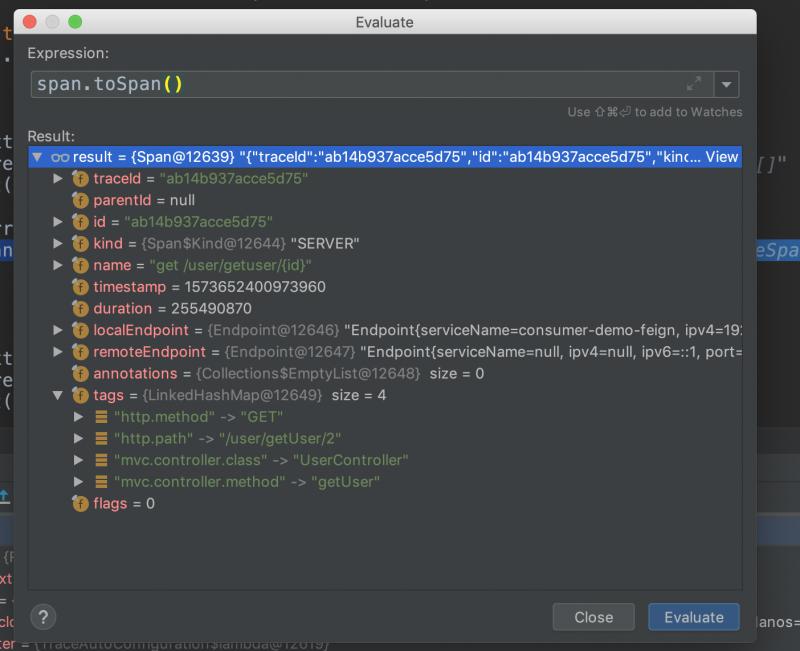Zipkin客户端链路追踪源码解析
我们知道,Zipkin这个工具可以帮助我们收集分布式系统中各个系统之间的调用连关系,而且除了Servlet之外还能收集:MQ、线程池、WebSocket、Feign、Hystrix、RxJava、WebFlux等等组件之间的调用关系。本篇文章就来分析一下Zipkin是如何完成这些功能的
我们先以最常用的Servlet接受请求为例来分析
在spring-cloud-sleuth的spring.factories文件中注入的很多类中包含了一个类:TraceWebServletAutoConfiguration,一看就知道,这是为Servlet环境量身定制的一个自动装配类
在这个类中,创建了一个Filter,这个Filter就是拦截web请求,完成Servlet请求链路的收集的利器
@Bean
@ConditionalOnMissingBean
public TracingFilter tracingFilter(HttpTracing tracing) {
return (TracingFilter) TracingFilter.create(tracing);
}
我们直接来看这个拦截器都是做了一些什么东西吧
public void doFilter(ServletRequest request, ServletResponse response, FilterChain chain) throws IOException, ServletException {
HttpServletRequest httpRequest = (HttpServletRequest)request;
HttpServletResponse httpResponse = this.servlet.httpResponse(response);
TraceContext context = (TraceContext)request.getAttribute(TraceContext.class.getName());
if (context != null) {
Scope scope = this.currentTraceContext.maybeScope(context);
try {
chain.doFilter(request, response);
} finally {
scope.close();
}
} else {
Span span = this.handler.handleReceive(this.extractor, httpRequest);
request.setAttribute(SpanCustomizer.class.getName(), span.customizer());
request.setAttribute(TraceContext.class.getName(), span.context());
Throwable error = null;
Scope scope = this.currentTraceContext.newScope(span.context());
try {
chain.doFilter(httpRequest, httpResponse);
} catch (ServletException | RuntimeException | Error | IOException var19) {
error = var19;
throw var19;
} finally {
scope.close();
if (this.servlet.isAsync(httpRequest)) {
this.servlet.handleAsync(this.handler, httpRequest, span);
} else {
this.handler.handleSend(ADAPTER.adaptResponse(httpRequest, httpResponse), error, span);
}
}
}
}
Span的创建
第一步,尝试从request中获取TraceContext,TraceContext包含了本次请求的链路信息,假如这个请求是从上游系统过来的话,那么这里就会存在这个信息。
我们先重点看不存在上游系统时的分支,这个时候,第一步就应该去创建一个span。关于span和trace的概念上篇文章已经提到过了,这里就不再展开了。
public <C> Span handleReceive(TraceContext.Extractor<C> extractor, C carrier, Req request) {
Span span = nextSpan(extractor.extract(carrier), request);
span.kind(Span.Kind.SERVER);
return handleStart(request, span);
}
Span nextSpan(TraceContextOrSamplingFlags extracted, Req request) {
if (extracted.sampled() == null) { // Otherwise, try to make a new decision
extracted = extracted.sampled(sampler.trySample(adapter, request));
}
return extracted.context() != null
? tracer.joinSpan(extracted.context())
: tracer.nextSpan(extracted);
}
这个三目表达式的意思是看当前环境中是否存在span,如果存在则加入当前环境的span,否则继续进入创建span的逻辑
public Span nextSpan(TraceContextOrSamplingFlags extracted) {
TraceContext parent = extracted.context();
if (extracted.samplingFlags() != null) {
TraceContext implicitParent = currentTraceContext.get();
if (implicitParent == null) {
return toSpan(newContextBuilder(null, extracted.samplingFlags())
.extra(extracted.extra()).build());
}
// fall through, with an implicit parent, not an extracted one
parent = appendExtra(implicitParent, extracted.extra());
}
if (parent != null) {
TraceContext.Builder builder;
if (extracted.samplingFlags() != null) {
builder = newContextBuilder(parent, extracted.samplingFlags());
} else {
builder = newContextBuilder(parent, sampler);
}
return toSpan(builder.build());
}
TraceIdContext traceIdContext = extracted.traceIdContext();
if (extracted.traceIdContext() != null) {
Boolean sampled = traceIdContext.sampled();
if (sampled == null) sampled = sampler.isSampled(traceIdContext.traceId());
return toSpan(TraceContext.newBuilder()
.sampled(sampled)
.debug(traceIdContext.debug())
.traceIdHigh(traceIdContext.traceIdHigh()).traceId(traceIdContext.traceId())
.spanId(nextId())
.extra(extracted.extra()).build());
}
// TraceContextOrSamplingFlags is a union of 3 types, we've checked all three
throw new AssertionError("should not reach here");
}
首先会尝试获取trace,因为是第一次请求,所以这个时候trace也不存在所以会进入到toSpan方法
public Span toSpan(TraceContext context) {
if (context == null) throw new NullPointerException("context == null");
TraceContext decorated = propagationFactory.decorate(context);
if (!noop.get() && Boolean.TRUE.equals(decorated.sampled())) {
return RealSpan.create(decorated, recorder, errorParser);
}
return NoopSpan.create(decorated);
}
这里如果我们没有特殊指定的话会使用RealSpan来创建span,这个span的最终实现类是AutoValue_RealSpan
接着返回最开始的handleReceive方法
public <C> Span handleReceive(TraceContext.Extractor<C> extractor, C carrier, Req request) {
Span span = nextSpan(extractor.extract(carrier), request);
span.kind(Span.Kind.SERVER);
return handleStart(request, span);
}
span创建完毕后就会设置kind,这个kand代表了服务类型,这里就是设置了服务类型为服务端。
接下来就是去开启记录链路信息
Span handleStart(Req request, Span span) {
if (span.isNoop()) return span;
Scope ws = currentTraceContext.maybeScope(span.context());
try {
parser.request(adapter, request, span.customizer());
Endpoint.Builder remoteEndpoint = Endpoint.newBuilder();
if (parseRemoteEndpoint(request, remoteEndpoint)) {
span.remoteEndpoint(remoteEndpoint.build());
}
} finally {
ws.close();
}
return span.start();
}
开启过程中记录了几个信息
public <Req> void request(HttpAdapter<Req, ?> adapter, Req req, SpanCustomizer customizer) {
customizer.name(spanName(adapter, req));
String method = adapter.method(req);
if (method != null) customizer.tag("http.method", method);
String path = adapter.path(req);
if (path != null) customizer.tag("http.path", path);
}
public Span start() {
return start(clock.currentTimeMicroseconds());
}
synchronized MutableSpan start(long timestamp) {
span.timestamp(this.timestamp = timestamp);
return this;
}
接着在回到文章最开始提到的Filter方法中
在span和trace创建完成后,会把它们添加到request中
Scope的创建
然后是一个scope的创建,这个scope和日志组件说息息相关的。简单来说,它会把traceId、parentId、spanId打印到当前系统打印的每一行日志中
public Scope newScope(@Nullable TraceContext currentSpan) {
final String previousTraceId = MDC.get("traceId");
final String previousParentId = MDC.get("parentId");
final String previousSpanId = MDC.get("spanId");
final String spanExportable = MDC.get("spanExportable");
final String legacyPreviousTraceId = MDC.get(LEGACY_TRACE_ID_NAME);
final String legacyPreviousParentId = MDC.get(LEGACY_PARENT_ID_NAME);
final String legacyPreviousSpanId = MDC.get(LEGACY_SPAN_ID_NAME);
final String legacySpanExportable = MDC.get(LEGACY_EXPORTABLE_NAME);
if (currentSpan != null) {
String traceIdString = currentSpan.traceIdString();
MDC.put("traceId", traceIdString);
MDC.put(LEGACY_TRACE_ID_NAME, traceIdString);
String parentId = currentSpan.parentId() != null ?
HexCodec.toLowerHex(currentSpan.parentId()) :
null;
replace("parentId", parentId);
replace(LEGACY_PARENT_ID_NAME, parentId);
String spanId = HexCodec.toLowerHex(currentSpan.spanId());
MDC.put("spanId", spanId);
MDC.put(LEGACY_SPAN_ID_NAME, spanId);
String sampled = String.valueOf(currentSpan.sampled());
MDC.put("spanExportable", sampled);
MDC.put(LEGACY_EXPORTABLE_NAME, sampled);
log("Starting scope for span: {}", currentSpan);
if (currentSpan.parentId() != null) {
if (log.isTraceEnabled()) {
log.trace("With parent: {}", currentSpan.parentId());
}
}
}
else {
MDC.remove("traceId");
MDC.remove("parentId");
MDC.remove("spanId");
MDC.remove("spanExportable");
MDC.remove(LEGACY_TRACE_ID_NAME);
MDC.remove(LEGACY_PARENT_ID_NAME);
MDC.remove(LEGACY_SPAN_ID_NAME);
MDC.remove(LEGACY_EXPORTABLE_NAME);
}
Scope scope = this.delegate.newScope(currentSpan);
class ThreadContextCurrentTraceContextScope implements Scope {
@Override public void close() {
log("Closing scope for span: {}", currentSpan);
scope.close();
replace("traceId", previousTraceId);
replace("parentId", previousParentId);
replace("spanId", previousSpanId);
replace("spanExportable", spanExportable);
replace(LEGACY_TRACE_ID_NAME, legacyPreviousTraceId);
replace(LEGACY_PARENT_ID_NAME, legacyPreviousParentId);
replace(LEGACY_SPAN_ID_NAME, legacyPreviousSpanId);
replace(LEGACY_EXPORTABLE_NAME, legacySpanExportable);
}
}
return new ThreadContextCurrentTraceContextScope();
}
Span的上送
接下来当剩下的执行链执行完毕后,本次请求也就该结束了。在请求结束时,span就会被上送到Zipkin服务端中
public void handleSend(@Nullable Resp response, @Nullable Throwable error, Span span) {
handleFinish(response, error, span);
}
void handleFinish(@Nullable Resp response, @Nullable Throwable error, Span span) {
if (span.isNoop()) return;
try {
Scope ws = currentTraceContext.maybeScope(span.context());
try {
parser.response(adapter, response, error, span.customizer());
} finally {
ws.close(); // close the scope before finishing the span
}
} finally {
finishInNullScope(span);
}
}
首先在span中记录本次调用的相应信息
public <Resp> void response(HttpAdapter<?, Resp> adapter, @Nullable Resp res,
@Nullable Throwable error, SpanCustomizer customizer) {
int statusCode = 0;
if (res != null) {
statusCode = adapter.statusCodeAsInt(res);
String nameFromRoute = spanNameFromRoute(adapter, res, statusCode);
if (nameFromRoute != null) customizer.name(nameFromRoute);
String maybeStatus = maybeStatusAsString(statusCode, 299);
if (maybeStatus != null) customizer.tag("http.status_code", maybeStatus);
}
error(statusCode, error, customizer);
}
接着清空Scope
void finishInNullScope(Span span) {
Scope ws = currentTraceContext.maybeScope(null);
try {
span.finish();
} finally {
ws.close();
}
}
之后说span的上传
public void finish(TraceContext context) {
MutableSpan span = spanMap.remove(context);
if (span == null || noop.get()) return;
synchronized (span) {
span.finish(span.clock.currentTimeMicroseconds());
reporter.report(span.toSpan());
}
}
具体上传的实现是由Sender接口的实现类实现的,它的实现类默认情况下是这三个
屏幕快照 2019-11-18 下午10.31.01
而一个span内容则是这样的
屏幕快照 2019-11-13 下午9.45.27
RabbitMQ链路追踪
当看完SpringMVC链路追踪的实现方式之后,再去看其他的方式,我想肯定是非常简单的。这里我们以RabbitMQ为例:
首先查找spring-cloud-sleuth的spring.factories文件,看到关于消息中间件的追踪配置类是这个TraceMessagingAutoConfiguration
看这个类关于RabbitMQ的东西
@Configuration
@ConditionalOnProperty(value = "spring.sleuth.messaging.rabbit.enabled", matchIfMissing = true)
@ConditionalOnClass(RabbitTemplate.class)
protected static class SleuthRabbitConfiguration {
@Bean
@ConditionalOnMissingBean
SpringRabbitTracing springRabbitTracing(Tracing tracing,
SleuthMessagingProperties properties) {
return SpringRabbitTracing.newBuilder(tracing)
.remoteServiceName(properties.getMessaging().getRabbit().getRemoteServiceName())
.build();
}
@Bean
@ConditionalOnMissingBean
static SleuthRabbitBeanPostProcessor sleuthRabbitBeanPostProcessor(BeanFactory beanFactory) {
return new SleuthRabbitBeanPostProcessor(beanFactory);
}
}
这里其实大致就可以猜测出来了,肯定是使用了SleuthRabbitBeanPostProcessor在构造RabbitTemplate的使用做了一些改造,比如说加个拦截器啥的,然后当使用RabbitTemplate发送消息时自动添加Header等东西就完成了整个流程了
博客所有文章首发于公众号《Java学习录》转载请保留
推荐阅读
扫码关注公众号即可领取2000GJava学习资源





 浙公网安备 33010602011771号
浙公网安备 33010602011771号